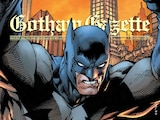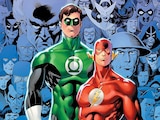The titular family of Bedrock is back, trying to figure out what civilization is in a way that mirrors our own great leap toward the unknown of our age.
Our main character is Fred Flintstone, a guy just trying to make it in the new world. He works at the quarry for a swinging and slimy Mr. Slate. Class struggles are woven throughout the book and it works so well at mirroring our own American society while giving us the lens and distance to laugh at it.
In the original cartoon series, which ran from 1960 -1966, the use of pop culture elements was a device and it worked well. But artist Steve Pugh and writer Mark Russell deepen the stakes here by taking those nods even further. Clever cameos make the book a pure delight as they lead the hunt for all pop culture references. This use of pop culture icons is not only multifaceted, but it works so well, doubly so because Fred has now become a pop culture icon himself.

There are thrilling pieces of brilliance in every issue, and it is from simple things that these inspired moments spring. Russell’s sense of story is a wonder to behold. He manages to take what seems simple and make it profound. For example, Wilma’s artistic life and deeply moving connection to handprint art, which at first just seems like a clever nod to the times they are actually living in, deepens once she has her encounter with art snobs at her gallery showing. It becomes a moving moment of humanity as she explains to Fred what the handprints mean to her, and it allows for a tender moment between man and wife.


Another brilliant stroke in this masterful reboot is the way that Fred and Barney’s relationship is handled. It’s rare to see a strong male friendship depicted in popular entertainment, one where men share their feelings and fears. You really feel the deep friendship between these two men, who move through the world in very different ways, but are bonded by being a new kind of man. Here that open honesty is cleverly introduced in the support meetings that Fred and Barney go to at the Veterans of the Paleolithic Wars.
Let me talk about how much I love the look of the characters. Pugh’s character designs are a bold and confident update on the originals. These characters are not the shlubby Fred and Barney we grew up with. You actually believe that they could survive in a time when people had to hunt and gather. There is nothing soft about them. Feminism blooms in young Punk Rock Pebbles (can I please own all of her t-shirts and copy her hairstyle?) and playful Bam Bam, who is no slouch or budding bro here. They both strike right to the heart of modern tweendom. They are still innocent enough to be young and fresh, but we can also see them trying to define themselves as who they are as the first generation and inheritors of this civilization experiment.
Chris Chuckry’s colors add to the lush world created in the 21st Century reboot. The colors are bright in the way that we are used to from the cartoon, but here Chuckry adds a slight mute to the color that cuts the sunniness and keeps it real. This subtle softness works to situate the action as taking place in the past and gives the book a surprisingly edgy feel. The flashbacks that are stitched throughout the first volume firmly root us in time and help the reader to triangulate the complex socio-historical conversation the book is having with us. And what a fun conversation it is!
Tiny moments glow. Fred, when asked why he wears a tie at a quarry job, says that he once heard you should dress for the job you want, and he’s been wearing that tie for fifteen years. Fred and Wilma buck the established norm by rejecting the Bedrock’s traditional sex cave and instead trying out a new thing called marriage. Barney and Betty’s fertility struggles and the way that Bam Bam comes into their lives is hauntingly beautiful. Pebbles and Bam Bam navigating the politics of middle school and the burgeoning field of science is hilarious. Even the animated animal appliances have their own rich inner life and philosophical quandaries going on.

And that’s the thing about this book—war, consumerism, greed, keeping up with the joneses, media, religion and science are all dealt with and the commentary keeps coming. No subject is taboo to tackle—at one point Wilma pointedly realizes their newest deity is a vacuum cleaner—and the stakes for this world spill off the page as they make a sharp comment on our own world.
The thing that is genius about writing a book that is about characters trying to figure out and invent civilization is that we the reader are sitting at the end game of their efforts. We can laugh about it as they grapple with—and sometimes stumble through—hard questions. We can see where they get it “wrong” or “right.” But the way that they stumble and the questions they ask ultimately force us to look at what we get wrong in our own times. It begs the question: Aren’t we all just Fred Flintstone? Are we perhaps worshipping vacuum cleaners, working for pebbles and basically getting it all wrong? Probably.
Each individual issue in this first collected volume works well on its own, but the book really shines as a collection. I could go on and point out a million threads and moments that I adore, but really I would just be walking you through every page and panel of every issue. In The Flintstones, no panel is frivolous. They all count and contribute something. Nothing is wasted in the story. Every single thing—words, art, color—is used in service to the larger narrative and the commentary on our American world.

Filled with whimsy, gravitas and pathos, Mark Russell and Steve Pugh’s Flintstones is a book that a person can read lightly for some good laughs and nostalgia, or pore over for hours to dig deep into the commentary on what it means to try to become a modern man. It’s gorgeous and funny and heartbreaking and very deep.
If there was ever the time for a Flintstones reboot, that time is now, as we step into a confusing moment in our own history where we’re trying to define what it means to be a great country. The Flintstones offer color commentary on our own societal grappling and is a beacon of hope in what sometimes seems like a dark age. Russell and Pugh have crafted a story that says we humans can figure it out and try things on collectively for size and then grow and learn as we awaken to the possibilities of what being civilized means. The Flintstones is a new gorgeous, smart take on an old classic. A true treasure.
Cecil Castellucci is the writer of DC Young Animal's SHADE, THE CHANGING GIRL. Look for its first trade collection on July 12, 2017. THE FLINTSTONES VOL. 1 is now available everywhere in print and as a digital download.















